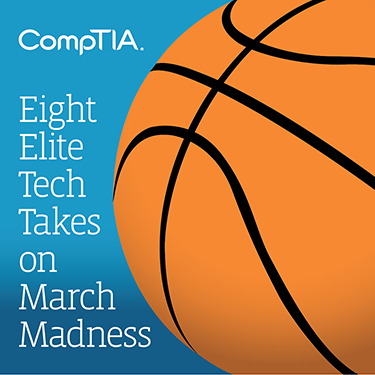by
Daniel Margolis
| Mar 15, 2017
 "The ball is tipped, and there you are...." wondering how the NCAA puts on such a magical show every year. While technology can't prevent a Cinderella team from busting everyone's brackets, it does play a large role in how the tournament operates. Read on to get eight looks at how high-stakes college basketball and technology interact.
"The ball is tipped, and there you are...." wondering how the NCAA puts on such a magical show every year. While technology can't prevent a Cinderella team from busting everyone's brackets, it does play a large role in how the tournament operates. Read on to get eight looks at how high-stakes college basketball and technology interact.
1. Bracketology
Filling out your bracket used to be a combination of guess work, instinct and, ideally, wide and deep knowledge of the current college basketball field. These days, people and companies use predictive modeling and analytics to see how well machine learning and statistical techniques can improve the ability to forecast NCAA tournament winners.
2. Online Tickets
Students at schools with hot basketball teams line up at box offices well in advance of games to score tickets. But for those without a student ID or faculty pass, NCAA tickets are even harder to get, and March Madness sees ticket sales surge at online companies like StubHub. Meanwhile, some schools are starting to allow mobile ticketing, so your smartphone serves as your ticket.
3. Tech Sponsors
Just like the Super Bowl, March Madness games have become a parade of nationally targeted, expensive ads, with tech companies in the mix of course. The NCAA itself has some prominent ones as direct sponsors – telecommunications behemoth AT&T, the Amazon Echo, Microsoft’s Bing and cell phone manufacturer LG.
4. Televised Tech
If you ever flip past an old March Madness matchup on ESPN Classic, you’ll notice they used to just look like games in gyms, though very well attended and tricked out, with a full band, cheerleaders and a mascot. These days, they’re almost like a movie – shot from all angles, incorporating sophisticated editing, graphics and detail-oriented, slow-motion replays.
5. App Madness
There’s certainly no shortage of mobile apps to help you track the tournament. The NCAA has three, ESPN and CBS, of course, have their own, and then hundreds of other companies and developers get in the mix. Some of these simply help fans track scores and games while others organize gambling and pools.
6. Live Streaming
In days of yore, fans watched games in person or on television, and you had to hope you weren’t stuck at work when the game you wanted to see was on. Today, you can stream every March Madness game from any kind of device. Don’t be surprised if the data usage in your company spikes a bit this month.
7. Robot Journalists
Sports writing can be formulaic, with the score, winning team and quotes from the players plugged into article templates for quick publication. But in 2015, the Associated Press began creating automated recaps of NCAA games using data-driven software programs. This frees up sports journalists to focus on the storylines of the tournament.
8. Digital Whistles
It used to be the case that when the referee blew his whistle, a scoreboard operator on the sideline would stop the game clock. Not anymore. These days, when the ref blows his whistle, the clock stops automatically thanks to a timing device that every on-court official carries.
Want more? Check out the infographic.